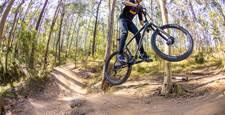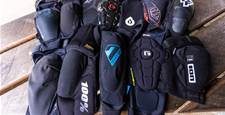The Scott Spark 2022 is here. Right in time for Leogang, and right in time for Tokyo.
On the cusp of the 2021 Tokyo Olympics, and days before the 3rd round of the 2021 cross-country World Cup, Scott Sports released what many expected was coming - a new Scott Spark full-suspension bike. At a glance, there is a new hidden shock location, longer travel on the Spark RC, the move to a flex stay, the ability to carry two water bottles and adjustable geometry.
Just like the previous Spark range, the Spark RC is aimed right at those doing bar-to-bar battle between the tape, with a shorter travel fork for aggressive racing with superb suspension capability. The Spark range is more like a light and fast trail bike, with suspension and geometry that lean more into the trail realm. Does this make it one of the most advanced mountain bikes available?

Many Scott Spark favourites remain, like the TwinLoc suspension control and super light weight. But here's a closer look at the details.
The hidden suspension on the Scott Spark
Probably what stands out most is the hidden shock, and this was done to achieve a better overall package. By moving the Trunnion mounted shock into the frame, and reducing the size of the link while doing so, the Scott engineers could fine tune the frame design. The frame delivers 120mm of travel for both the Spark and Spark RC. The Spark RC is designed around a 120mm travel fork, while the Spark has 130mm travel forks.

The result of the new design is bigger bearings at the main pivot, and better overall strength around the lower part of the bike. So you end up with a bike where the rear suspension tracks better thanks to greater stiffness. This is something the previous Spark (launched in 2016) already addressed over the design before that, when it moved to the vertically mounted trunnion shock
There's a cover on the base of the humungous down tube so you can access the rear shock to adjust air pressure, rebound and of course the cable for the remote lock out.

We don't have a test bike, but while the access is easy enough, for those who want to check their air pressure before most rides (this is something worth doing) - it's still a drag. Kudos to Scott for making this tool free access though.

A port on the non-drive side has been designed into the bike to keep an eye on sag settings, along with a guide near the pivot that measures articulation so you understand what percentage sag you have. So it's not all guess work when you can't see the shock.
Flexstays, chain lines and water bottles
Scott stay committed to their single pivot design, but as the Spark is a short travel bike, they have removed the rear drop out pivot and rely on the right layup of carbon fiber instead.

The frame weights are listed below, and at 1870g the frame for the top model is light - but possibly not the lightest out there. Weight is one thing, ride characteristics is another.



The TwinLoc and a new lever
Scott's TwinLoc has been around since forever. When I raced on a Scott Genius RC in 2005, one of the great features was how you could have the rear shock set at 3 positions so easily. From being locked out, it was easy to move to Traction Control, or fully open. The pull shock used on those Genius models was interesting, but let's be happy that the Nude shocks took over. The TwinLoc concept has remained, and it moved to a neat underbar package with the rise of 1x group sets. It now also gets a dropper lever down there.

It is worth noting that this isn't just a remote lock out with a third position. The middle Traction Control position does change the size of the air chamber, changing compression, limiting travel and also helping the bike sit higher in its sag. The keeps you forward and aids in pedal clearance. So it's perfect for fast trails where you're on the pedals a lot, and technical climbs where the benefit of dual suspension for traction is there, but you don't want to sink into plush travel. Flicking between the modes becomes second nature.

So, does it look like there is a lot going on there? Yes, it does. While I rode and raced a Scott Spark or Genius from 2005-2012, that was on 3x9, 3x10 or 2x10. And while I never had a dropper post, it did still mean the left side was a mix of shifters and TwinLoc levers. And only in the most hypoxic state in high alpine races would I ever make a small mistake about what lever was what. I can really only think of doing it a couple of times in 8 years and lots of races and adventures.
Cable integration
I think dual remote lock out and a dropper are par for the course on a fast and light trail bike or full-suspension XC rig at the moment. But that can create a real mess of cables and outers. Scott worked with their in-house brand Syncros on keeping cables and outers matched to the base of the one piece Fraser bar and stem, and they enter the head tube neatly.

Canyon have done this with the Exceed, and Merida have with the Ninety Six. The Ninety Six is a little clunky, primarily around choosing what side of the head tube an outer or hose goes depending on if you ride left to rear brakes or not. It's easy for this to look good on bikes shot for international press, but I'd be interested to see how the Scott Sparks look on the shop floor and on the trail.
The headset cups can be rotated 180 degrees in that massive head tube to steepen or slacken the head angle by 0.6 degrees, which can help you tune your bike to how you ride.
Geometry on the Spark RC and Spark
Scott have often been quite progressive with their geometry. Years ago the Genius was running long reach with a 65 degree head angle, dare I say it, 'before it was cool'. And their chief designer had even thought about going longer and slacker, but admitted that it takes a lot of effort to ride a bike hard all the time - and that's what progressive geometry demands.

So, you'll see the Scott Sparks are slack, with a 67.2 degree head angle on the Spark RC with 120mm travel forks, which goes to 65.8 on the Spark with 130mm travel forks. The seat angles are steeper, around 76 degrees depending on what size and variant. The larger sizes have steeper seat angles to keep you centred. Reach is a little over 470mm in large which is modest and modern in one.

Probably the biggest takeaway for the racing crowd here is the shift to 120mm travel front and back and that the likelihood of that platform winning a World Cup is just a matter of time. Perhaps even this weekend in Leogang.

We've already seen riders opting to 34mm and 35mm legged forks for greater stiffness and better handling, and with wider rims and tyres, dropper posts and longer and slacker geometry on XC bikes it's clear that the cross-country bike of the modern age is super capable.

And in that sense - Scott may have set the bar higher yet again, with a bike that meets the demands of their World Cup team, and the rest of us who just want to get out and ride fast.
Spark RC and Spark models
Like anything in the Scott range, there are a million choices! Some say Scott are like the Giant of Europe - in that their range is really extensive. This means that while these photos are all of exotic carbon bikes, the same technology runs into the alloy frames. That includes the integrated shock, flex stay, internal cable routing from the head tube and more.
Interestingly, Scott state that they had to completely redesgin some of their processes to achieve the same results in alloy, and so they were able to completely rethink elements of the frame engineering to ensure the ride quality of the alloy frames matches that of the carbon.
As to whether the Spark is one of the most advanced mountain bikes ever, there's a chance that it is - in it's own area. Scott have looked at the demands of their World Cup team, their team riders away from the XC scene, and riders like us, and delivered a versatile bike that is light, ticks all the boxes for modern standards, and is potentially easier to look after with the shock tucked away. And the Spark platform has some potential to spice up the short travel trail bike world.

I think with the growth of wireless technology the whole Spark package will get even cleaner looking. SRAM have pushed hard in this realm bringing AXS all the way to the GX level - but is the more scope for ergonomic improvement and integration with components? The new Scott Spark platform has the capability there with the wider chain line for updates in the tyre and rim realm, along with adjustable geometry and smart design cues. It looks to be a truly amazing bike - and one that is very advanced. As for weight? We don't have a test bike to verify and weight claims, so stay tuned.
For full pricing and spec details, head to the Scott website, or visit your local dealer.

Related Articles

RockShox Flight Attendant learns as you ride!

Superior Bikes find a home with BikesOnline












